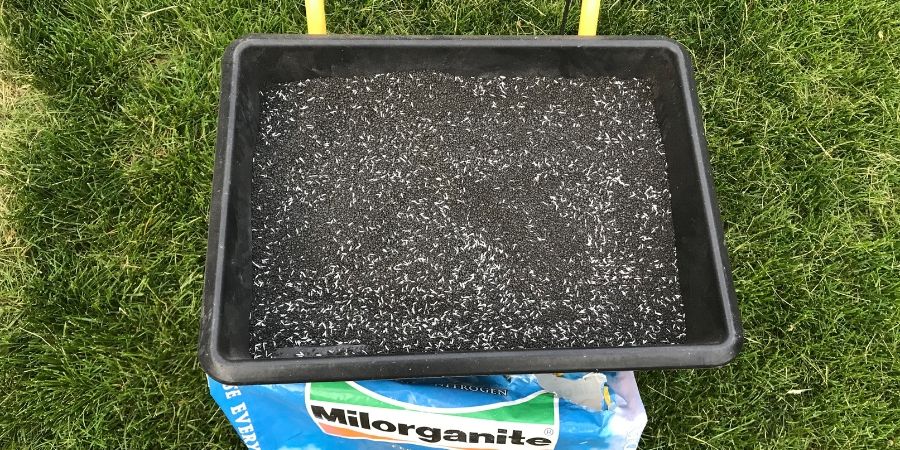What Shouldn't I Do to My Lawn in Fall?
- Milorganite AgronomistAugust 30, 2025
Summer is coming to an end. Daylight is giving way to darkness by minutes every day. Sweltering heat is hopefully subsiding, and we can all enjoy the cooler fall weather, as do lawns. Here are some fall lawn care tips you don’t want to forget that are essential to maintaining a healthy lawn throughout the year.

Fall is the Time to Aerate: Don't Skip It Northern Lawns!
Don’t skip aerating cool-season grasses in early fall while the grass is still actively growing, which will give it time to recover. Never aerate dormant lawns, as they may not have time to recover. Those with warm-season grasses have a one-season reprieve and should wait to aerate until late spring or early summer the following year.
Soil easily compacts over time, which can suffocate and starve your lawn. As little as 1/4”–1/2” of compacted soil can impact a lawn’s health. Aeration helps loosen compacted soil and penetrate thatch to allow water, air, and nutrients to reach the root system. If there’s more than 1/2” of thatch, dethatch before aerating.
Aeration creates holes in the soil. Spike aerators (solid tine aerators) poke holes in the soil, but may cause some additional compaction by pressing the soil around the holes. A core aerator, preferred by lawn care professionals, removes small cores of grass and soil, bringing them to the surface. Multiple passes in different directions is recommended to remove as many plugs as possible. After the cores dry they can be broken up and distributed. The soil will work its way back into the lawn. After aerating, it's a good time to overseed your lawn.
For heavily used lawns, aerating every two years or so is recommended. Examples of heavy use include play areas and pathways created by repetitive walking. Lawn and garden equipment, and small vehicles also compact soil.
The soil of newly constructed homes has been compacted by construction equipment. These new lawns should be aerated annually for several years. Lawns growing in clay soil would benefit from annual aeration.
Best Time to Overseed Your Lawn is Fall: Don't Forget!
Don’t wait to overseed your lawn until late fall. Grass seed establishes best in warm soil, which encourages germination, and cool air to encourage growth. In the north, cool-season grasses are best seeded in late-summer to early-fall, when grass is actively growing and daytime temperatures are consistently in the low- to mid-70sF. Spring is the second-best time to overseed.

Mix 4 parts Milorganite with 1 part seed by weight to overseed this fall
Overseed warm-season grasses in late-August to mid-September when the existing lawn starts to lose its color. Use a cool-season grass variety to keep your lawn green throughout winter while warm-season grasses are dormant. When the summer heat and rain return, the cool-season grass variety will die as the warm-season grass comes out of dormancy. Overseeding warm-season grasses is done annually.
If there’s more than 1/2” of thatch, it may be necessary to remove it before overseeding so seeds have better contact with the soil. Although not essential, aeration is helpful in preparing to overseed lawns as well. It loosens soil and provides grass seed better soil contact.
Before overseeding, mow as low as your mower will go. This also helps provide better soil contact for the seeds and allows more sunlight to reach the germinating seeds.
Use a slow-release nitrogen fertilizer, such as Milorganite, when overseeding. Mixing Milorganite with the seed not only makes nutrients available to the grass when it needs it, it also makes it easier to see where the tiny seeds have been broadcast. This counts as the fall fertilization.
Allow grass to grow to its optimum mowing height, which varies by variety, before mowing it for the first time. Follow the one-third rule: never remove more than 1/3 of the grass blade when mowing.

Herbicides and Overseeding: Don’t Apply Herbicides Too Soon
If you apply an herbicide, you’ll have to wait 6–8 weeks to overseed. Wait until the grass is established before applying an herbicide. Exactly how long to wait varies by grass variety and growing conditions.
Pre-emergent herbicides will prevent grass seed from germinating, as it does weed seeds. Post-emergent herbicides are selective and target specific weeds. No matter what weeds it’s intended to kill, it may also kill the newly sprouted grass if applied too soon.
Herbicide labeling should indicate how long to wait before or after overseeding. Also, make sure the herbicide won’t kill the grass varieties in your lawn along with the weeds. Always follow manufacturer instructions and community guidelines for herbicide applications.
If you fertilize at the same time you’re overseeding, don’t make the mistake of using a weed ‘n feed product. Fertilize with a slow-release nitrogen fertilizer, such as Milorganite.
Don’t Forget to Fertilize this Fall
If you only have time to fertilize your lawn once a year, fall is the best and most important time. Grass is looking for a satisfying meal as it builds-up a food reserve prior to winter slumber. The roots will be strong and healthy, and your lawn will be better prepared to green up quickly in spring.
Milorganite is an ideal fertilizer for a fall application. In the north, we recommend applying Milorganite around Labor Day and once again around Thanksgiving, before the first major freeze or snowfall. In the south, apply Milorganite around Labor Day and again in early-October. You can also fertilize in conjunction with overseeding, which replaces fall fertilization.
Don’t Mow in the Same Direction
Although it applies year-round, not just in fall, don’t let your lawn-mowing habits inhibit your lawn. Mow in a different direction and pattern every time you mow. Mowing in the same direction every time can actually be problematic. The repeated pattern can cause ruts and grass will tend to lean in one direction. Alternate mowing patterns to reduce the chance of ruts forming and encourage upright growth.



